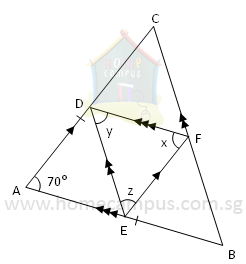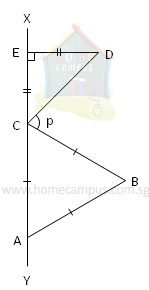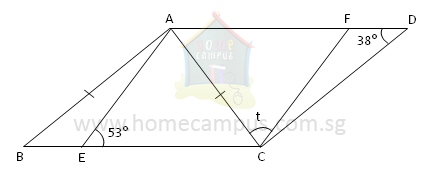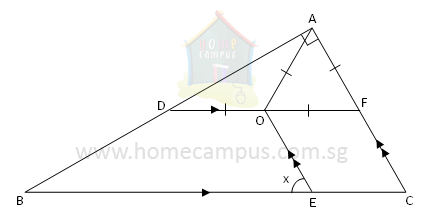Geometry: Finding Unknown Angles (Advanced Problems)
Problem 1: In the figure below, ABC and DEF are triangles. AC = AB, AB // DF, BC // ED, AC // EF and ∠ CAB = 70°. Find ∠ x, ∠ y and ∠ z.

Δ ABC is an isosceles triangle.
∠ ACB = ∠ ABC
= (180° − 70°) ÷ 2
= 55°
= (180° − 70°) ÷ 2
= 55°
DF // AE and AD // EF
So, AEFD is a parallelogram.
So, AEFD is a parallelogram.
∠ DAE = ∠ DFE
= 70°
∠ x = 70°
= 70°
∠ x = 70°
DF // EB and DE // FB
So, DEBF is a parallelogram.
So, DEBF is a parallelogram.
∠ EBF = ∠ EDF
= 55°
∠ y = 55°
= 55°
∠ y = 55°
DE // CF and DC // EF
So, DEFC is a parallelogram.
So, DEFC is a parallelogram.
∠ DCF = ∠ DEF
= 55°
∠ z = 55°
= 55°
∠ z = 55°
Problem 2: Sally makes a flag using two triangles, ABC and CDE, on a straight pole XY as shown below. Triangle ABC is an equilateral triangle. Triangle CDE is a right-angled isosceles triangle with EC = ED and ∠ CED = 90°. Find the unknown angle, ∠ p, between the two triangles.

Δ CDE is a right-angled isosceles triangle.
∠ ECD = ∠ EDC
= (180° − 90°) ÷ 2
= 45°
= (180° − 90°) ÷ 2
= 45°
Δ ABC is an equilateral triangle.
∠ ACB = 60°
ECA is a straight line.
∠ ECD + ∠ p + ∠ ACB = 180°
∠ p = 180° − ∠ ECD − ∠ ACB
= 180° − 45° − 60°
= 75°
∠ ECD + ∠ p + ∠ ACB = 180°
∠ p = 180° − ∠ ECD − ∠ ACB
= 180° − 45° − 60°
= 75°
Problem 3: The figure below shows a parallelogram AECF inside another parallelogram ABCD. AB = AC, ∠ AEC = 53° and ∠ FDC = 38°. Find ∠ t.

Opposite angles of a parallelogram are equal.
In the Parallelogram ABCD,
∠ ABC = ∠ ADC
= ∠ FDC
= 38°
∠ ABC = ∠ ADC
= ∠ FDC
= 38°
Δ ABC is an isosceles triangle as AB = AC.
In the Isosceles Triangle ABC,
∠ ABC = ∠ ACB = 38°
∠ ABC = ∠ ACB = 38°
Sum of adjacent angles of a parallelogram is 180°.
In the Parallelogram AECF,
∠ EAF = 180° − ∠ AEC
= 180° 53°
= 127°
∠ EAF = 180° − ∠ AEC
= 180° 53°
= 127°
Opposite angles of a parallelogram are equal.
∠ FCE = ∠ EAF
= 127°
= 127°
∠ t = ∠ FCE − ∠ ACE
= ∠ FCE − ∠ ACB
= 127° − 38°
= 89°
= ∠ FCE − ∠ ACB
= 127° − 38°
= 89°
Problem 4: In the figure below, ABCD is a rhombus and ADE is a straight line. ∠ DAB = 51° and ∠ DCE = 42°. Find ∠ x and ∠ y.

Opposite angles of a rhombus are equal.
In the Rhombus ABCD,
∠ BCD = ∠ DAB = 51°
∠ BCD = ∠ DAB = 51°
AD // BC and ADE is a straight line.
Hence, DE // BC and BCED is a trapezium.
Hence, DE // BC and BCED is a trapezium.
In the Trapezium BCED,
∠ x = 180° − ∠ BCE
= 180° − ∠ BCD − ∠ DCE
= 180° − 51° − 42°
= 87°
∠ x = 180° − ∠ BCE
= 180° − ∠ BCD − ∠ DCE
= 180° − 51° − 42°
= 87°
BC = CD as all sides of a rhombus are equal.
Triangle BCD is an isosceles triangle.
∠ y = ∠ BDC
= (180° − 51°) ÷ 2
= 64.5°
∠ y = ∠ BDC
= (180° − 51°) ÷ 2
= 64.5°
Problem 5: ABC is a right-angled triangle with ∠ BAC = 90°. OA = OD = OF. EO // CA and DO // BC. Find ∠ x.

Triangle AOF is an equilateral triangle.
∠ AOF = ∠ OFA = ∠ FAO = 60°
∠ AOF = ∠ OFA = ∠ FAO = 60°
∠ DAF = 90°
∠ OAD = 90° − 60°
= 30°
∠ OAD = 90° − 60°
= 30°
Triangle AOD is an isosceles triangle.
∠ OAD = ∠ ODA = 30°
∠ OAD = ∠ ODA = 30°
ADB is a straight line.
∠ ODB = 180° − ∠ ODA = 150°
∠ ODB = 180° − ∠ ODA = 150°
DBEO is a trapezium.
∠ DBE = 180° − ∠ ODB
∠ DBE = 180° − 150° = 30°
∠ DBE = 180° − ∠ ODB
∠ DBE = 180° − 150° = 30°
∠ ABC = ∠ DBE = 30°
In Triangle ABC,
∠ ACB = 180° − ∠ BAC − ∠ ABC
= 180° − 90° − 30°
= 60°
∠ ACB = 180° − ∠ BAC − ∠ ABC
= 180° − 90° − 30°
= 60°
∠ FCE = ∠ ACB = 60°
OECF is a trapezium.
∠ CEO = 180° − ∠ FCE
= 120°
∠ CEO = 180° − ∠ FCE
= 120°
BEC is a straight line.
∠ x = 180° − ∠ CEO
= 180° − 120°
= 60°
∠ x = 180° − ∠ CEO
= 180° − 120°
= 60°